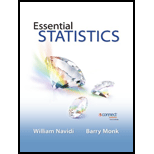
Concept explainers
Keep your password safe: A computer password consists of eight characters. Replications are allowed.
- a. How many different passwords are possible if each character may be any lowercase letter or digit?
- b. How many different passwords are possible if each character may be any lowercase letter?
- c. How many different passwords are possible if each character may be any lowercase letter or digit, and at least one character must be a digit?
- d. A computer is generating passwords. The computer generates eight characters at random, and each is equally likely to be any of the 26 letters or 10 digits. Replications are allowed. What is the
probability that the password will contain all letters? - e. A computer system requires that passwords contain at least one digit. If eight characters are generated at random, what is the probability that they will form a valid password?
a.
Find the possible number of passwords.
Answer to Problem 36E
There are
Explanation of Solution
Calculation:
The password consists 8 characters. Replications are possible. Each character are either lowercase letters or digits.
The Fundamental Principle of Counting:
If an action can be perform in m ways and another action can be perform in n ways then both the action can be done together in mn different ways.
The password consist 8 characters. Each character are either lowercase letters or digits.
Each digit can arrange in 10 different ways and letters can arrange in 26 different ways. That is each character can be arranged in 36
Thus, there are
b.
Find the possible number of passwords if each character may be any lowercase letters.
Answer to Problem 36E
There are
Explanation of Solution
Calculation:
The number plate contains lowercase letters. Each letters can arrange in 26 different ways. Substitute these values in the fundamental principle of counting.
Thus, there are
c.
Find the possible number of passwords if each character may be any lowercase letters or digits, and at least one character must be digit.
Answer to Problem 36E
There are
Explanation of Solution
Calculation:
Number of passwords with each character may be any lowercase letters or digits, and at least one character must be digit can be obtained by the formula:
From part (a), it is clear that there are
From part (b), it is clear that there are
Substitute these values in the above equation.
Therefore, required number is,
Thus, there are
d.
Find the probability that the password will contain all letters.
Answer to Problem 36E
The probability that the password will contain all letters is 0.074.
Explanation of Solution
Calculation:
The probability of an event can be obtained as shown below:
Event A denotes that the password will contain all letters.
From part (a), total number of password is
From part (b), numbers of password will contain all letters is
Substitute
The required probability is obtained as follows:
Thus, the probability that the password will contain all letters is 0.074.
e.
Find the probability that the password contain at least one digit form a valid password.
Answer to Problem 36E
The probability that the password contain at least one digit form a valid password is 0.9260.
Explanation of Solution
Calculation:
Event B denotes that the password contain at least one digit.
From part (a), total number of password is
From part (c), numbers of password will contain at least one digit is
Substitute
The required probability is obtained as follows:
Thus, the probability that the password contain at least one digit form a valid password is 0.9260.
Want to see more full solutions like this?
Chapter 4 Solutions
Essential Statistics
- Show all workarrow_forwardplease find the answers for the yellows boxes using the information and the picture belowarrow_forwardA marketing agency wants to determine whether different advertising platforms generate significantly different levels of customer engagement. The agency measures the average number of daily clicks on ads for three platforms: Social Media, Search Engines, and Email Campaigns. The agency collects data on daily clicks for each platform over a 10-day period and wants to test whether there is a statistically significant difference in the mean number of daily clicks among these platforms. Conduct ANOVA test. You can provide your answer by inserting a text box and the answer must include: also please provide a step by on getting the answers in excel Null hypothesis, Alternative hypothesis, Show answer (output table/summary table), and Conclusion based on the P value.arrow_forward
- A company found that the daily sales revenue of its flagship product follows a normal distribution with a mean of $4500 and a standard deviation of $450. The company defines a "high-sales day" that is, any day with sales exceeding $4800. please provide a step by step on how to get the answers Q: What percentage of days can the company expect to have "high-sales days" or sales greater than $4800? Q: What is the sales revenue threshold for the bottom 10% of days? (please note that 10% refers to the probability/area under bell curve towards the lower tail of bell curve) Provide answers in the yellow cellsarrow_forwardBusiness Discussarrow_forwardThe following data represent total ventilation measured in liters of air per minute per square meter of body area for two independent (and randomly chosen) samples. Analyze these data using the appropriate non-parametric hypothesis testarrow_forward
 Holt Mcdougal Larson Pre-algebra: Student Edition...AlgebraISBN:9780547587776Author:HOLT MCDOUGALPublisher:HOLT MCDOUGAL
Holt Mcdougal Larson Pre-algebra: Student Edition...AlgebraISBN:9780547587776Author:HOLT MCDOUGALPublisher:HOLT MCDOUGAL
 College Algebra (MindTap Course List)AlgebraISBN:9781305652231Author:R. David Gustafson, Jeff HughesPublisher:Cengage Learning
College Algebra (MindTap Course List)AlgebraISBN:9781305652231Author:R. David Gustafson, Jeff HughesPublisher:Cengage Learning
 Algebra and Trigonometry (MindTap Course List)AlgebraISBN:9781305071742Author:James Stewart, Lothar Redlin, Saleem WatsonPublisher:Cengage Learning
Algebra and Trigonometry (MindTap Course List)AlgebraISBN:9781305071742Author:James Stewart, Lothar Redlin, Saleem WatsonPublisher:Cengage Learning College AlgebraAlgebraISBN:9781305115545Author:James Stewart, Lothar Redlin, Saleem WatsonPublisher:Cengage Learning
College AlgebraAlgebraISBN:9781305115545Author:James Stewart, Lothar Redlin, Saleem WatsonPublisher:Cengage Learning





